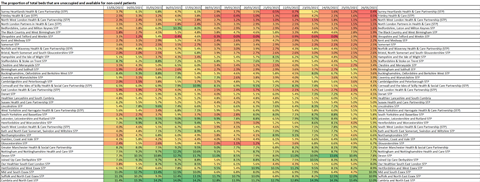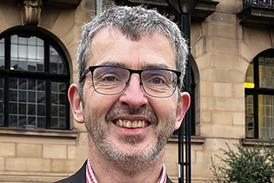Several areas of England have been left with just a handful of general hospital beds available for non-covid patients in recent days, under the combined pressures of coronavirus and winter, HSJ analysis reveals.
It shows that on 26 January the Frimley and Surrey Heartlands health systems had under 1 per cent of their unoccupied beds available for non-covid patients (see chart below). Both systems continue to treat high numbers of covid patients as well as sizeable numbers of patients without covid.
Frimley, which spans Surrey and Berkshire, had around 1,000 general and acute beds with 108 of them unoccupied, on 26 January. However, just six were available to non-covid patients. Surrey Heartlands had nearly 850 general and acute beds, with 42 unoccupied — three were available for non-covid patients.
The number of beds unoccupied and available for different types of patient fluctuates as people are discharged and admitted. But even looking on average across the seven days to 26 January, both Frimley and Surrey Heartlands had under 2 per cent of their beds unoccupied and available for non-covid patients (19 and 16 beds respectively).
Hospitals have had to segregate their bed base to ensure they can continue to treat high numbers of covid patients while also trying to treat patients without covid. On top of that, covid outbreaks on supposedly covid-free wards and bays sees even more areas converted for covid infection control. This means that only a share of the beds which they report as “unoccupied” are also available for non-covid patients.
The dwindling number of beds available for non-covid patients is exacerbating the challenge of avoiding emergency departments becoming overloaded, and will make it difficult to tackle the burgeoning backlog of patients who need planned inpatient operations.
Systems in London are also operating with a small proportion of their bed base unoccupied and available for non-covid patients. Data shows the north west and north central London health systems have limited capacity for non-covid patients.
General acute trusts in north central London have been treating high volumes of covid patients throughout the pandemic and had less than 2 per cent (about 53) of their 2,000 collective adult G&A beds unoccupied and available for non-covid patients, on average in the week up to 26 January.
The system does in addition have the specialist Royal National Orthopaedic Hospital Trust on its patch, giving it on average a further 26 beds unoccupied and available for non-covid patients, but it is not a traditional general hospital with an emergency department.
North west London’s system had, on average, 1.3 per cent (23 beds) of approximately 1,800 adult G&A beds unoccupied and available for non-covid patients in the week to 26 January. However, our analysis of this system has had to exclude Imperial College Healthcare Trust because of apparent gaps in the dataset, so the complete picture is unclear.
The Shropshire and Telford and Wrekin system has also struggled with capacity for non-covid patients in its acute trust, Shrewsbury and Telford Hospital Trust with an average of 1.4 per cent of its G&A beds (nine beds) open and available for non-covid patients.
The system includes a specialist trust, The Robert Jones and Agnes Hunt Orthopaedic Hospital Foundation Trust, which, on average, gave it an additional 15 of its 23 unoccupied beds available for non-covid patients in the week to 26 January, but does not have a “type one” general emergency department.
Trusts have also had to close beds to create extra space to allow for social distancing and because of higher staff absence rates. There are now approximately 8,000 fewer general and acute beds than there were in total last winter.

Source
HSJ analysis of NHSE data
Source Date
January 2020



























1 Readers' comment